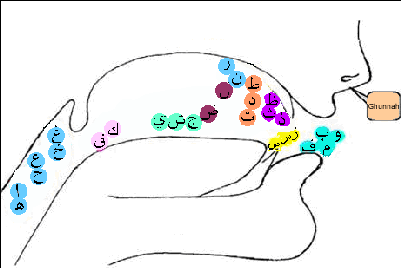BDIslam.Com
Your Islamic Education Resources
Table of Contents
- Introduction
- Virtues of reading Qur'an
- Etiquettes of Qur'an
- Alphabet
- Four Forms
- Fathah
- Kasrah
- Dhammah
- Two Fathah
- Two Kasrah
- Two Dhammah
- Introduction to Tajweed
- Sukun
- QalQalah
- Fathah + Ya Sukun
- Fathah + Wa Sukun
- Shaddah
- Introduction to Gunnah
- Long Fathah
- Fathah + Alif
- Long Kasrah
- Kasrah + Ya Sukun
- Long Dhammah
- Dhammah + Wa Sukun
- Introduction to Madd
- Signs of Madd
- Muqata'aat Letters
- Shamsi & Qamari Letters
- Small Nuun
- Punctuation
- The letter Raw
- Laam in the word "Allah"
- Ta Marbutah
- Hamzah
- Practice Reading
- Advanced Tajweed
- Makhaarij
- Sifat
- Madd
- Madd followed by Hamzah
- Madd followed by Sukun
- Others Madd
- Gunnah
- Meem Sakin
- Nuun Sakin & Tanween
- Idhghaam
- Modes of Recitation
- Miscellaneous
- Glossary
Browse our site
Request
Find BDIslam helpful!!!
Please let others know. If otherwise, please let us know.
You are here: BDIslam Home > Learn Quran > Lesson 35 : Makhaarij
![]()
Lesson 35 : The Makhaarij of the Letters
Definition : The correct position of the organs of speech in order to produce a letter so that it can be differentiated from others. This is equally so whether the letter is a consonant or a vowel.
Being able to recite the letters correctly is the foundation of tajweed, and this is achieved by knowing where the sound originates. This can then help in practising the pronunciation of the letters correctly.
The diagram below gives a snapshot of where each letter originates :

However, Makhaarij must be used hand in hand with sifa (characteristics of the letter) in order to pronounce the letter completely and correctly, as the Makhraj provides the origin and the Sifa provides extra information required to pronounce the letter properly.
To achieve the correct makhraj of a letter, practise via placing a sukoon on it, and precede it with an alif / hamzah with a Fathah, Kasrah or Dhammah. To do so, please visit our Sukun page.
There are 5 main categories of Makhaarij :
1. The oral cavity or Al Jawf
2. The throat Al Halq
3. The tongue Al Lissaan
4. The lips Ash-shafatain
5. The nasal cavity Al Khayshoom
1. The oral cavity or Al Jawf :
This is all the empty space that occurs from the chest, up the throat and out through the mouth.
It is the makhraj of the long vowels ( AA, EE and UU) sounds (also known as the elongated letters) and is elongated for 2 counts:
For practice please see the following pages.
1. Long Fatha
2. Fatha + Alif
3. Long Kasra
4. Kasra + Ya Saakina
5. Long Dhammah
6. Dhammah + Waw Saakin
2. The throat Al Halq :
In the throat there are 3 makhaarij and each one has 2 letters:
1. From the uppermost point of the throat : Ghawyn and Khaw
2. From the mid point of the throat : Ay'n and Haa
3. From the lowest point of the throat : Hamza or Alif and small Haa
Remember to practise pronouncing letters by placing a sukoon in front of the letter from our Sukun page.
3. The tongue Al Lissaan :
Many letters come from the mouth: that is the tongue and its connection with the different areas of the teeth and mouth
There are 4 main makhaarij that can be divided into 10 sub-categories:
A. The furthest back part of the tongue - this has 2 sub categories:
i. The letter Qawf is pronounced by the extreme back of the tongue touching the upper palate to create a thick sound in the tonsils vicinity, with a round sound
ii. The letter Kaaf The makhraj is slightly in front of the Qawf. This time the tongue should not meet the upper palate other than what is necessary to pronounce the letter. So the sound still comes from the back of the tongue, except this time the tongue is not elevated
B. The middle of the tongue - this single makhraj covers 3 letters:
The letters are Jeem, Sheen and Yaa
These are all pronounced when the middle part of the tongue comes in contact with what lies opposite to it from the roof of the mouth
C. The side of the tongue - this has 2 specific points of articulation:
i. The letter Dawd The rear side of the tongue touches the upper back teeth (upper molars) in either one of 3 ways : from the right side, from the left side OR from both sides. The left side of the tongue is most commonly used as it is easier than the right, and usage of both sides of the tongue is rare
4. The lips Ash-shafatain : coming soon Insha Allah
5. The nasal cavity Al Khayshoom : coming soon Insha Allah
Thank you and Jazakallahu khairan for visiting BDIslam.Com!

‘How perfect You are O Allah, and I praise You. I bear witness that none has the right to be worshipped except You. I seek Your forgiveness and turn to You in repentance.’